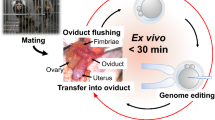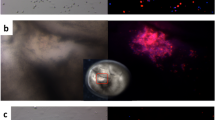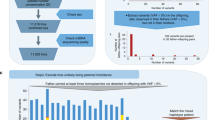Abstract
Eukaryotic cells contain two distinct genomes. One is located in the nucleus (nDNA) and is transmitted in a mendelian fashion, whereas the other is located in mitochondria (mtDNA) and is transmitted by maternal inheritance. Cloning of mammals1,2,3,4,5,6 typically has been achieved via nuclear transfer, in which a donor somatic cell is fused by electoporation with a recipient enucleated oocyte. During this whole-cell electrofusion, nDNA as well as mtDNA ought to be transferred to the oocyte7,8. Thus, the cloned progeny should harbour mtDNAs from both the donor and recipient cytoplasms, resulting in heteroplasmy. Although the confirmation of nuclear transfer has been established using somatic cell-specific nDNA markers, no similar analysis of the mtDNA genotype has been reported. We report here the origin of the mtDNA in Dolly, the first animal cloned from an established adult somatic cell line, and in nine other nuclear transfer-derived sheep generated from fetal cells. The mtDNA of each of the ten nuclear-transfer sheep was derived exclusively from recipient enucleated oocytes, with no detectable contribution from the respective somatic donor cells. Thus, although these ten sheep are authentic nuclear clones, they are in fact genetic chimaeras, containing somatic cell-derived nuclear DNA but oocyte-derived mtDNA.
This is a preview of subscription content, access via your institution
Access options
Subscribe to this journal
Receive 12 print issues and online access
$209.00 per year
only $17.42 per issue
Buy this article
- Purchase on Springer Link
- Instant access to full article PDF
Prices may be subject to local taxes which are calculated during checkout


Similar content being viewed by others
References
Cibelli, J.B. et al. Cloned transgenic calves produced from nonquiescent fetal fibroblasts. Science 280, 1256–1258 (1998).
Meng, L., Ely, J.J., Stouffer, R.L. & Wolf, D.P. Rhesus monkeys produced by nuclear transfer. Biol. Reprod. 57, 454–459 (1997).
Wakayama, T., Perry, A.C.F., Zuccotti, M., Johnson, K.R. & Yanagimachi, R. Full-term development of mice from enucleated oocytes injected with cumulus cell nuclei. Nature 394, 369–374 (1998).
Wells, D.N., Misica, P.M., Day, T.A. & Tervit, H.R. Production of cloned lambs from an established embryonic cell line: a comparison between in vivo- and in vitro-matured cytoplasts. Biol. Reprod. 57, 385–393 (1997).
Wilmut, I., Schnieke, A.E., McWhir, J., Kind, A.J. & Campbell, K.H.S. Viable offspring derived from fetal and adult mammalian cells. Nature 385, 810–813 (1997).
Schnieke, A.E. et al. Human factor IX transgenic sheep produced by transfer of nuclei from transfected fetal fibroblasts. Science 278, 2130–2133 (1997).
Gaertig, J., Kiersnowska, M. & Iftode, F. Induction of cybrid strains of Tetrahymena thermophila by electrofusion. J. Cell Sci. 89, 253–261 (1988).
Sekirina, G.G., Bogoliubova, N.A., Antonova, N.V. & Dyban, A.P. The behaviour of mitochondria and cell integration during somatic hybridisation of sister blastomeres of the 2-cell mouse embryo. Zygote 5, 97–103 (1997).
Piko, L. & Taylor, K.D. Amounts of mitochondrial DNA and abundance of some mitochondrial gene transcripts in early mouse embryos. Dev. Biol. 123, 364–374 (1987).
Chen, X. et al. Rearranged mitochondrial genomes are present in human oocytes. Am. J. Hum. Genet. 57, 239–247 (1995).
King, M.P. & Attardi, G. Human cells lacking mtDNA: repopulation with exogenous mitochondria by complementation. Science 246, 500–503 (1989).
Giles, R.E., Blanc, H., Cann, H.M. & Wallace, D.C. Maternal inheritance of human mitochondrial DNA. Proc. Natl Acad. Sci. USA 77, 6715–6719 (1980).
Kaneda, H. et al. Elimination of paternal mitochondrial DNA in intraspecific crosses during early mouse embryogenesis. Proc. Natl Acad. Sci. USA 92, 4542–4546 (1995).
Ankel-Simons, F. & Cummins, J.M. Misconceptions about mitochondria and mammalian fertilization: implications for theories on human evolution. Proc. Natl Acad. Sci. USA 93, 13859–13863 (1996).
Wood, N.J. & Phua, S.H. Variation in the control region sequence of the sheep mitochondrial genome. Anim. Genet. 27, 25–33 (1996).
Lightowlers, R.N., Chinnery, P.F., Turnbull, D.M. & Howell, N. Mammalian mitochondrial genetics: heredity, heteroplasmy and disease. Trends Genet. 13, 450–455 (1997).
Pinkert, C.A., Irwin, M.H., Johnson, L.W. & Moffatt, R.J. Mitochondria transfer into mouse ova by microinjection. Transgenic Res. 6, 379–383 (1997).
Shitara, H., Hayashi, J.I., Takahama, S., Kaneda, H. & Yonekawa, H. Maternal inheritance of mouse mtDNA in interspecific hybrids: segregation of the leaked paternal mtDNA followed by the prevention of subsequent paternal leakage. Genetics 148, 851–857 (1998).
Cummins, J.M., Wakayama, T. & Yanagimachi, R. Fate of microinjected sperm components in the mouse oocyte and embryo. Zygote 5, 301–308 (1997).
Meirelles, F.V. & Smith, L.C. Mitochondrial genotype segregation in a mouse heteroplasmic lineage produced by embryonic karyoplast transplantation. Genetics 145, 445–451 (1997).
Meirelles, F.V. & Smith, L.C. Mitochondrial genotype segregation during preimplantation development in mouse heteroplasmic embryos. Genetics 148, 877–883 (1998).
Jenuth, J.P., Peterson, A.C., Fu, K. & Shoubridge, E.A. Random genetic drift in the female germline explains the rapid segregation of mammalian mitochondrial DNA. Nature Genet. 13, 146–151 (1996).
Jenuth, J.P., Peterson, A.C. & Shoubridge, E.A. Tissue-specific selection for different mtDNA genotypes in heteroplasmic mice. Nature Genet. 16, 93–95 (1997).
Schon, E.A., Bonilla, E. & DiMauro, S. Mitochondrial DNA mutations and pathogenesis. J. Bioenerg. Biomembr. 29, 131–149 (1997).
Ciafaloni, E. et al. Widespread tissue distribution of a tRNALeu(UUR) mutation in the mitochondrial DNA of a patient with MELAS syndrome. Neurology 41, 1663–1665 (1991).
Silvestri, G. et al. Clinical features associated with the A→G transition at nucleotide 8344 of mtDNA ("MERRF" mutation). Neurology 43, 1200–1206 (1993).
Ferlin, T. et al. Segregation of the G8993 mutant mitochondrial DNA through generations and embryonic tissues in a family at risk of Leigh syndrome. J. Pediatr. 131, 447–449 (1997).
Rubenstein, D.S., Thomasma, D.C., Schon, E.A. & Zinaman, M.J. Germ-line therapy to cure mitochondrial disease: protocol and ethics of in vitro ovum nuclear transplantation. Camb. Q. Healthc. Ethics 4, 316–339 (1995).
Cohen, J. et al. Ooplasmic transfer in mature human oocytes. Mol. Hum. Reprod. 4, 269–280 (1998).
Buchanan, F.C., Littlejohn, R.P., Galloway, S.M. & Crawford, A.M. Microsatellites and associated repetitive elements in the sheep genome. Mamm. Genome 4, 258–264 (1993).
Acknowledgements
We thank E.A. Shoubridge, M. Hirano and S.C. Silverstein for helpful discussions. This work was supported by grants from the National Institutes of Health (NS28828; NS11766; HD32062; HL52145) and the Muscular Dystrophy Association.
Author information
Authors and Affiliations
Corresponding author
Rights and permissions
About this article
Cite this article
Evans, M., Gurer, C., Loike, J. et al. Mitochondrial DNA genotypes in nuclear transfer-derived cloned sheep. Nat Genet 23, 90–93 (1999). https://doi.org/10.1038/12696
Received:
Accepted:
Issue Date:
DOI: https://doi.org/10.1038/12696
This article is cited by
-
Preventing Common Hereditary Disorders through Time-Separated Twinning
BioNanoScience (2018)
-
Generation of cloned mice and nuclear transfer embryonic stem cell lines from urine-derived cells
Scientific Reports (2016)
-
Production of viable trout offspring derived from frozen whole fish
Scientific Reports (2015)
-
On Clone as Genetic Copy: Critique of a Metaphor
NanoEthics (2015)
-
Therapeutic potential of somatic cell nuclear transfer for degenerative disease caused by mitochondrial DNA mutations
Scientific Reports (2014)



